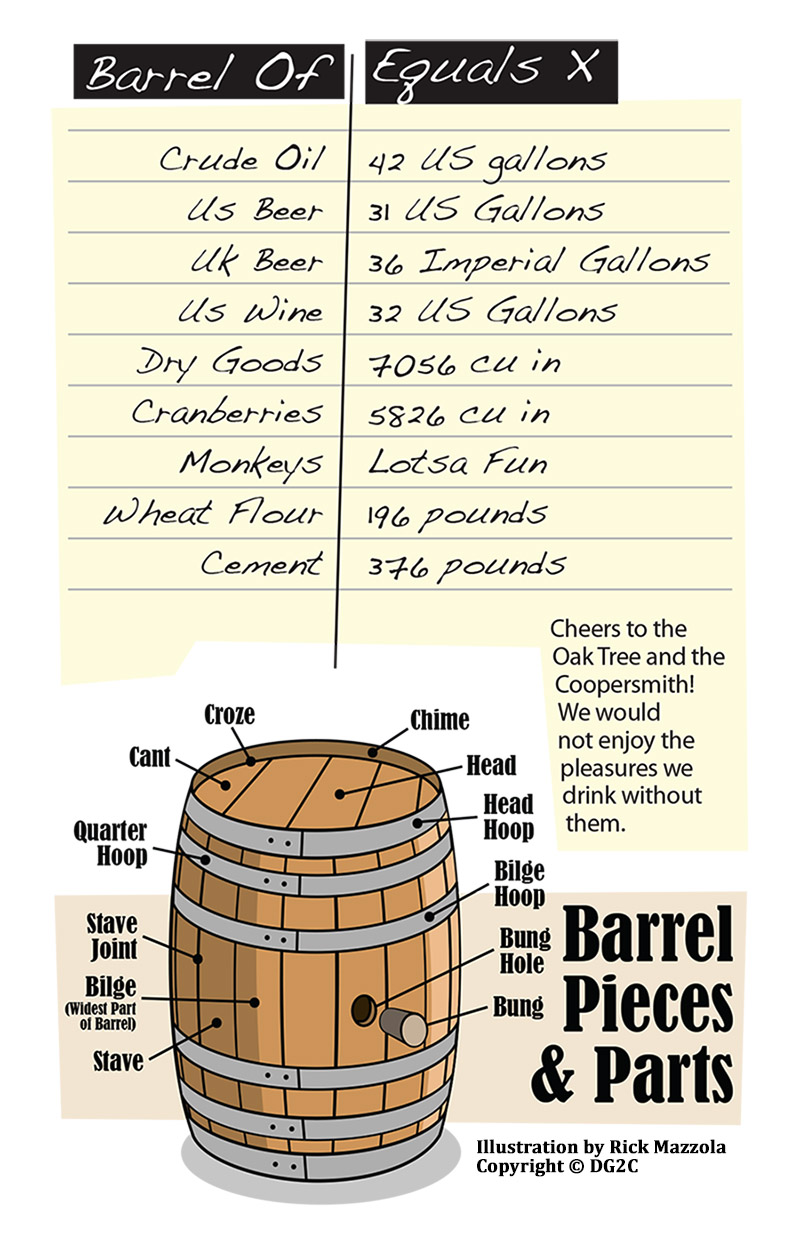When you put a batch of beer into an oak barrel for a few months or years, magical things can happen to it.
Nobody understands that better than Skyler Weeks, owner of Rocky Mountain Barrel Co., the main provider of oak barrels for Colorado breweries. While barrel-aged beers were once the purview of specialty breweries like Crooked Stave, these days it seems everyone is getting into the business of barrel-aged beers.
Weeks comes from a wine background. An oak cask for wine has a limited number of uses, maybe 4 years’ worth, and he was selling his used barrels to furniture makers. But today he sells barrels to some 160 Colorado breweries.
And it’s not just wine. Rum, bourbon, brandy, sherry - all are made in wooden casks that have limited use to distillers. Weeks travels the world for barrels, importing more than two dozen types from 23 different countries, 55,000 barrels in any given year. Since most breweries can’t afford to import an entire shipment of barrels, his company allows them to purchase one at a time, from $200 to $500 on average.
“Our job is to get those other barrels in the brewers’ minds. Until we came along there wasn’t a huge way to get these barrels. If you call a cognac producer in France they’re probably just going to laugh at you,” says Weeks.
Bourbon barrels are the top seller. Aging a stout or porter in these barrels adds a very distinct smoky flavor. Tequila and rum barrels are good for making high-alcohol beers. And wine barrels are good for sour beers, which seem to gain in popularity each year.
There isn’t always an abundance of barrels. Two years ago barrel-aging became suddenly huge in Scotland, which cornered the market and caused prices to double. And wine barrels can be difficult to find during the fall grape harvest in Napa Valley. But for the most part, the barrels are easily available for breweries.
Unlike distillers, many of whom can only use the barrel once, brewers can age batch after batch in oak barrels, year after year. It’s about creating something unique, in a craft beer market that gets more crowded by the day.
“You have 4,000 breweries in the U.S. Why is somebody going to pick your beer off the shelf versus the next competitor’s if it’s a dollar cheaper?” says Weeks. “One of the easiest ways is if you have a bottle of bourbon-aged stout right there ... It might be worth the extra dollar if it’s something nobody has ever heard of before. You can create a lot of buzz behind it.”
And it can give beer a story, a history. Weeks mentioned some Hennessy barrels that recently came on the market after 65 years of aging.
“If you’re the brewer and you’re talking about these tank and why your beer is $17 for a 12-ounce poor, well, the beer is in tanks that were filled since before Sputnick was launched. It was filled before JFK was in office,” he says.
“By the end of it, people are so interested in the history of these barrels and what’s actually gone on in the world since they were filled, you don’t mind paying a dollar more.”
It can be confusing: keg, barrel, hogshead, cask, tun, firkin, and, yes, the butt. They’re different names for different sized containers of our world’s various tradable products, terms used for centuries and still used today. No matter if measured in US gallons, Imperial gallons, liters, volume, or weight; in practice one person’s barrel may be bigger or smaller than another’s. So how big is your butt? Ours measures out at about 4 barrels, or 105 imperial gallons. See? Size does matter.

Nobody understands that better than Skyler Weeks, owner of Rocky Mountain Barrel Co., the main provider of oak barrels for Colorado breweries. While barrel-aged beers were once the purview of specialty breweries like Crooked Stave, these days it seems everyone is getting into the business of barrel-aged beers.
Weeks comes from a wine background. An oak cask for wine has a limited number of uses, maybe 4 years’ worth, and he was selling his used barrels to furniture makers. But today he sells barrels to some 160 Colorado breweries.
And it’s not just wine. Rum, bourbon, brandy, sherry - all are made in wooden casks that have limited use to distillers. Weeks travels the world for barrels, importing more than two dozen types from 23 different countries, 55,000 barrels in any given year. Since most breweries can’t afford to import an entire shipment of barrels, his company allows them to purchase one at a time, from $200 to $500 on average.
“Our job is to get those other barrels in the brewers’ minds. Until we came along there wasn’t a huge way to get these barrels. If you call a cognac producer in France they’re probably just going to laugh at you,” says Weeks.
Bourbon barrels are the top seller. Aging a stout or porter in these barrels adds a very distinct smoky flavor. Tequila and rum barrels are good for making high-alcohol beers. And wine barrels are good for sour beers, which seem to gain in popularity each year.
There isn’t always an abundance of barrels. Two years ago barrel-aging became suddenly huge in Scotland, which cornered the market and caused prices to double. And wine barrels can be difficult to find during the fall grape harvest in Napa Valley. But for the most part, the barrels are easily available for breweries.
Unlike distillers, many of whom can only use the barrel once, brewers can age batch after batch in oak barrels, year after year. It’s about creating something unique, in a craft beer market that gets more crowded by the day.
“You have 4,000 breweries in the U.S. Why is somebody going to pick your beer off the shelf versus the next competitor’s if it’s a dollar cheaper?” says Weeks. “One of the easiest ways is if you have a bottle of bourbon-aged stout right there ... It might be worth the extra dollar if it’s something nobody has ever heard of before. You can create a lot of buzz behind it.”
And it can give beer a story, a history. Weeks mentioned some Hennessy barrels that recently came on the market after 65 years of aging.
“If you’re the brewer and you’re talking about these tank and why your beer is $17 for a 12-ounce poor, well, the beer is in tanks that were filled since before Sputnick was launched. It was filled before JFK was in office,” he says.
“By the end of it, people are so interested in the history of these barrels and what’s actually gone on in the world since they were filled, you don’t mind paying a dollar more.”
What's In Your Butt
It can be confusing: keg, barrel, hogshead, cask, tun, firkin, and, yes, the butt. They’re different names for different sized containers of our world’s various tradable products, terms used for centuries and still used today. No matter if measured in US gallons, Imperial gallons, liters, volume, or weight; in practice one person’s barrel may be bigger or smaller than another’s. So how big is your butt? Ours measures out at about 4 barrels, or 105 imperial gallons. See? Size does matter.

